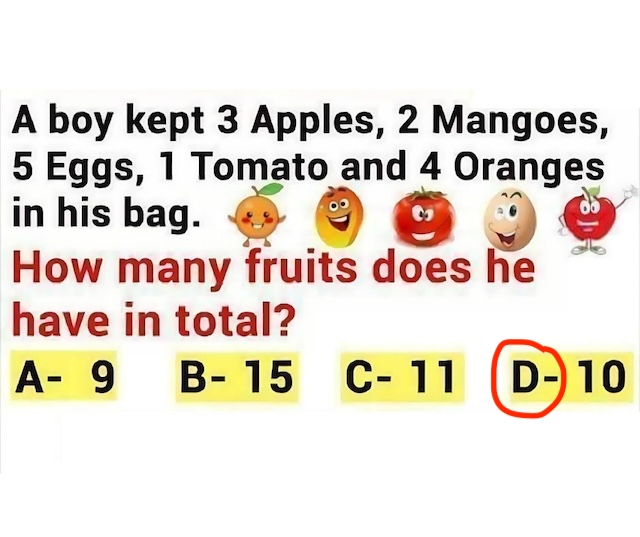Brain teasers are an excellent way to stimulate your mind, and some of the most straightforward puzzles can often trip you up. One popular puzzle asks you to figure out how many fruits are in a boy’s bag. Although the question appears simple at first, there are hidden challenges that can lead you astray if you’re not careful. Let’s dive into this brain teaser and break it down step by step to reveal the correct answer.

Why This Puzzle Can Be Tricky
At first glance, the question seems simple enough. The boy’s bag contains a variety of items, and your job is to count only the fruits. However, the trick lies in distinguishing between fruits and non-fruits, particularly based on botanical definitions. While it might sound easy, the mix of items – some familiar and others unexpected – can make it tricky.
Step 1: List All the Items in the Bag
To start, let’s take a look at everything in the boy’s bag. Here’s the list:
- 3 Apples
- 2 Mangoes
- 5 Eggs
- 1 Tomato
- 4 Oranges
At first, this list might seem a bit overwhelming, but don’t worry – we’ll simplify it soon enough.
Step 2: Identify Which Items Are Actually Fruits
Here’s where things get interesting. Not everything on the list is a fruit, and this is the key to solving the puzzle. Let’s go through each item:
- Apples: There’s no doubt about it – apples are fruits. They’re sweet, grow on trees, and meet every botanical definition of a fruit.
- Mangoes: Mangoes are fruits as well. These tropical fruits are known for their juicy sweetness. No argument here.
- Eggs: Eggs are definitely not fruits. They come from animals, not plants, so they don’t belong in the fruit category.
- Tomato: This one can be tricky. While many people think of tomatoes as vegetables due to their savory taste, scientifically, they are considered fruits. A fruit, by definition, is the part of a plant that develops from a flower and contains seeds, which applies to tomatoes.
- Oranges: Oranges are citrus fruits, rich in vitamin C, and clearly belong in the fruit category.
Step 3: Count the Fruits
Now that we’ve identified which items are fruits, let’s add them up:
- Apples: 3
- Mangoes: 2
- Tomato: 1
- Oranges: 4
Adding these together gives us:
3 + 2 + 1 + 4 = 10 fruits.
Step 4: Eliminate the Non-Fruits
To make sure we have the right total, we’ll remove the eggs from the count. Eggs are not fruits, and their inclusion could easily mislead you if you don’t pay close attention.
Why Tomatoes Are Technically Fruits
The tomato is often the source of confusion in this puzzle. While it’s widely considered a vegetable in the kitchen because of its savory flavor, it’s actually a fruit from a botanical perspective. Botanically speaking, fruits are seed-bearing parts of plants that develop from flowers. Since tomatoes fit this definition, they qualify as fruits – which is why they need to be counted in this puzzle.
Common Mistakes People Make
Here are some common pitfalls that people often encounter when solving this brain teaser:
- Including Eggs: It’s easy to get tricked into counting eggs because they’re listed alongside the fruits. However, eggs are animal products, not plant-based, so they should be excluded.
- Excluding Tomatoes: People often overlook tomatoes as fruits because of their culinary use. It’s important to remember that the scientific definition of a fruit is what matters here.
- Miscounting: With several items on the list, it’s easy to lose track and miscalculate. Breaking things down into categories (fruits and non-fruits) can help avoid this mistake.
The Final Answer: 10 Fruits
After carefully considering the botanical definitions and eliminating the non-fruits (eggs), the final total is 10 fruits. This includes the 3 apples, 2 mangoes, 1 tomato, and 4 oranges. The eggs do not count because they’re not fruits.

Why This Brain Teaser Is So Engaging
What makes this brain teaser especially intriguing is its blend of simplicity and trickery. It’s an exercise in critical thinking, where paying attention to details and applying your knowledge of fruits can help you arrive at the correct solution. This puzzle demonstrates how even the most seemingly straightforward questions can present unexpected challenges.
Conclusion
This brain teaser teaches us the importance of observation and careful reasoning. By breaking the problem down into manageable steps and focusing on the details, we can arrive at the correct answer – 10 fruits. It’s a fun reminder that even simple problems can hold complex solutions. So next time you come across a similar puzzle, you’ll be well-prepared to tackle it. Happy solving!





